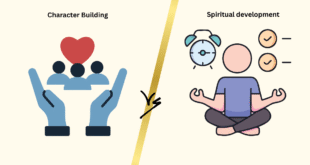Dr. Muhammad Younus Khalid- Tarbiyah Parenting Coach, Counseller and Consultant
In the field of Islamic education, one of the most beautiful and effective methods is Tarbiyah through Quran stories for kids. These narratives not only engage a child’s imagination, but also instill character, faith, and moral behavior in a subtle, lasting way.
In this article, we will explore how using Quran stories for children can serve as a powerful tool for Tarbiyah (character formation), the pedagogical principles behind it, practical tips for parents and teachers, and sample stories that can be taught at different ages.
What Is Tarbiyah — And Why Stories?
Before diving into techniques, it’s important to clarify what Tarbiyah means, and how it is distinct yet complementary to formal teaching (Taaleem). The word Tarbiyah encompasses more than just instruction; it includes nurturing, molding, educating the heart, mind, and character.
As some writers note, Tarbiyah is the raising up and education of a child such that he/she can reach full potential as a human and a Muslim — while Taaleem is limited to academic or factual instruction.
Stories, especially from the Quran—are a powerful medium for Tarbiyah because they reach children’s hearts, not just their minds. A well-chosen story can do the following:
- Convey deep spiritual and ethical lessons in a language children understand.
- Foster love and connection with the Prophets, with Allah’s guidance, and with the Qur’anic worldview.
- Encourage reflection and internalization, rather than rote memorization.
- Build a child’s moral vocabulary (e.g. patience, justice, trust, humility) in context.
- Serve as launching points for discussions, questions, and lived practice.
When parents and teachers use Quran stories for kids intentionally, they turn storytelling into a method of Tarbiyah through Quran stories for kids rather than mere entertainment.
Core Principles of Tarbiyah Through Quran Stories for Kids
To make this method effective, one should follow certain guiding principles. Below are essential elements for effective Tarbiyah through Quran stories for kids.
-
Choose Age-Appropriate Narratives & Language
Not every story or detail is suitable for every age. Young children (ages 4–7) need simpler language, shorter segments, and more visuals. Older children (8–12) can appreciate more depth, nuance, and challenge.
For example, a simplified version of the story of Prophet Nuh (Noah) might focus on perseverance and trust, while a fuller version can also discuss his dialogues with his people.
-
Emphasize Key Moral Themes
When telling the story, focus on one or two moral themes: patience (sabr), trust (tawakkul), gratitude (shukr), repentance (tawbah), humility, justice, etc. Avoid overwhelming children with many lessons at once. The narrative should spotlight the theme organically.
-
Encourage Reflection & Discussion
After narrating a story, pause to ask open-ended questions:
- “Why did the Prophet act this way?”
- “What would you do in that situation?”
- “Which part surprised you, and why?”
Encourage children to reflect on how the story applies to their day-to-day behavior, friends, school, family.
-
Relate to Contemporary Life
Bridge the classical story to modern life. For instance, after the story of Prophet Yusuf (Joseph), relate forgiveness to sibling conflicts. After the story of Musa and Pharaoh, connect courage and standing against wrongdoing in their own environment.
-
Repetition & Reinforcement
As with any Tarbiyah method, repetition over time helps internalization. Revisit stories, recite short verses associated with them, assign small activities (drawing, role-play, journaling) related to the story’s lesson.
-
Integrate with Quran & Du‘a
Whenever possible, include the relevant Qur’anic verses (in translation) and du‘a. This links the story back to the Qur’an itself and helps children see that these are not just fairy tales but divine guidance.
-
Model & Live the Lesson
Perhaps most importantly, parents/teachers must model the moral traits themselves. If you emphasize patience or forgiveness, the child must see it in your responses to their mistakes, sibling disputes, or daily frustrations.
Tarbiyah through Quran stories for kids works best when the adult also embodies the value.
With these principles in mind, let us explore how to implement this in a systematic way.
A Step-by-Step Method to Implement Tarbiyah Through Quran Stories for Kids
Below is a practical roadmap that parents, madrasa teachers, or homeschooling tutors can follow.
Phase 1: Preparation
- Select a suitable story
Choose a Prophetic or Qur’anic narrative fitting the child’s age and interest. Examples include Adam & Eve, Nuh (Noah), Ibrahim, Yusuf, Musa, Sulaiman, the People of the Cave, Maryam, etc. Various lists of Quran stories for kids exist online. - Read and understand deeply
As the adult, you must know the story well, its context, variant narrations, lessons, relevant verses. This gives confidence and allows you to adapt appropriately. - Simplify and adapt
Convert the story into child-friendly language, shorten or focus on key segments, omit overly complex theological or political details (unless teaching older children). - Prepare supporting materials
You might prepare visuals, flashcards, short verse cards, discussion questions, coloring pages, or dramatization ideas.
Phase 2: Storytelling Session
- Introduction / Hook
Begin with something to grab attention e.g., “One day, a boy faced an impossible test; what would you do in his place?” or “Let me tell you about a Prophet who was thrown into the fire…” - Narration
Tell the story with expressive tone, pacing, pauses, and engagement. Use facial expressions, gestures, or drawings. Emphasize the main moral theme. - Insert Qur’anic Verses / Du‘a
At suitable moments, pause and read a short verse (in translation) or recite a du‘a connected to the event (e.g. du‘a of Prophet Ibrahim). - Reflection & Q&A
Ask open-ended questions, let children wonder aloud, relate to their experience. - Activity / Reinforcement
After the story, do a related activity: drawing a scene, writing a short “what I learned” note, role-play a scene with siblings, or applying the lesson in real life over the coming days.
Phase 3: Follow-Up & Reinforcement
- Recall & retelling
After a few days, ask the child to retell the story (in their own words). This helps with retention and internalization. - Verse or hadeeth of the week
Use a short verse or hadeeth connected with that story. Encourage the child to memorize and reflect on it. - Behavior challenge
Suggest a simple practical challenge: e.g. “This week, try to respond with patience when someone bothers you — like Prophet Nuh did when people mocked him.” - Frequent revisits
Over weeks or months, revisit the same story from different angles (character focus, cause-effect, du‘a) to deepen understanding. - Family discussion
Make story time interactive: invite siblings, ask parents to share their reflections, and apply lessons in household life.
By following this roadmap, Tarbiyah through Quran stories for kids becomes a structured, repeatable practice rather than random storytelling.
Sample Stories & Their Tarbiyah Potential
Here are a few Quran stories adapted for children along with suggested moral lessons and possible discussion points.
-
The Creation of Adam and the Test
Narrative (simplified):
Allah created Adam from clay, breathed life into him, and placed him and his wife in Paradise. He told them they could enjoy everything in Paradise except one tree. Satan whispered to them, they ate, realized their mistake, repented, and were sent to Earth, where Allah guided them.
Moral lessons / Tarbiyah focus:
- Obedience to Allah’s command
- Human fallibility and the need for repentance
- Allah’s mercy and forgiveness
Discussion questions:
- Why did Adam and Eve eat from the forbidden tree?
- What does this teach us about temptation and repentance?
- If you make a mistake, how can you turn back to Allah?
Activity idea:
Ask children to draw two scenes — Paradise and Earth — and list one rule from Allah they would try not to break.
-
Prophet Nuh (Noah) and the Ark
Narrative (simplified):
Prophet Nuh was sent to his people over many years. He called them to believe in Allah and stop wrongdoing. Some believed, most rejected. Allah commanded Nuh to build an ark. Rain came and flood submerged the disbelievers, while believers and animals on the ark were saved.
Moral lessons / Tarbiyah focus:
- Patience in calling towards truth
- Trust in Allah to fulfill His promise
- Avoiding peer pressure and standing firm
Discussion:
- How hard was it for Nuh to call people who rejected him?
- What would you do if your friends teased you for doing good?
- Why did Allah save Prophet Nuh and disbelievers drown?
Activity:
Divide children into groups and let them plan what they would take onto an “ark” (virtues, good deeds) if they could.
-
The Story of Yusuf (Joseph)
Narrative (simplified):
Prophet Yusuf was beloved by his father, but his brothers envied him and threw him in a well. He was sold into slavery, falsely accused, imprisoned, and eventually rose to a high rank, forgiving his brothers when they came to him.
Moral lessons / Tarbiyah focus:
- Trust in Allah’s plan
- Patience under trials
- Compassion and forgiveness
Discussion:
- How did Yusuf remain patient when trials came?
- Why did he forgive his brothers?
- What can you learn when someone hurts you?
Activity:
Write a “letter of forgiveness” (imaginary) to someone you’ve had a fight with, applying what Yusuf did.
-
Musa (Moses) and Pharaoh
Narrative (simplified):
Allah appointed Musa to call Pharaoh to worship Allah. Pharaoh refused and oppressed the Israelites. Through a series of signs and miracles, Musa led his people out of Egypt, crossed the sea, and was saved.
Moral lessons / Tarbiyah focus:
- Courage to speak truth
- Standing against injustice
- Reliance on Allah in hardship
Discussion:
- What risks did Musa face?
- How do you stand for justice in school or with friends?
- What helps you when you feel afraid?
Activity:
Role-play a scene where Musa confronts Pharaoh (respectfully) or where a child stands up for someone bullied.
-
The People of the Cave (Ashab al-Kahf)
Narrative (simplified):
A group of young believers fled persecution, sought refuge in a cave, and Allah caused them to sleep for many years. When they awoke, their story amazed people, and their example of steadfastness became a lesson.
Moral lessons / Tarbiyah focus:
- Faith under pressure
- Divine protection for believers
- Time and Allah’s plan
Discussion:
- Why did the youths flee?
- What does their story teach about standing firm in faith?
- When are you tempted to hide your faith?
Activity:
Have children draw a cave and write one sentence: “If I had faith like them, I would…”
Adapting Tarbiyah Through Quran Stories for Different Age Groups
Ages 4–7
- Use very simple language, short segments, and plenty of repetition.
- Use visuals, illustrations, puppets, or cartoons.
- Emphasize one moral per story.
- Ask very concrete questions (“What would you do if…?”).
- Use songs or short chants of key verses (in translation or Arabic).
Ages 8–12
- Provide more contextual background (e.g. who was the people, what the social setting was).
- Introduce variant interpretations, subtle moral dilemmas.
- Ask more critical questions (“Was there another way?”, “What would you decide if…?”).
- Encourage journaling: “What part of this story changed me?”
- Integrate memorization of short verses and linking them to stories.
Teens (13+)
- Use full narrations or Tafsir-level details.
- Dive into the theological, historical, and moral complexities.
- Facilitate group debates: e.g., “When is it permissible to stand against injustice?”
- Encourage comparative study: cross-referencing hadith, Sirah, and Quranic stories.
- Assign projects: retell or dramatize with critical reflection.
By scaling details and questions, tarbiyah through Quran stories for kids remains appropriate across stages.
Overcoming Common Challenges in Tarbiyah Through Quran Stories
Children Losing Interest
- Keep sessions short (10–15 min for younger ages).
- Use multimedia (illustrations, video, animations) sparingly but wisely.
- Let them narrate or act parts themselves.
- Vary genres: occasionally include short parables or metaphors from the Qur’an.
Difficulty in Simplifying Without Distorting
- Study multiple resources (Tafsir, children’s versions) and maintain fidelity to the message.
- Avoid introducing myths or exaggerations.
- When omitting, inform children: “We will talk about that when you are older.”
Overemphasizing Punishment (Divine Wrath) Over Mercy
A common pitfall is that children internalize a fearful picture of Allah because many stories emphasize punishment or divine retribution. To balance:
- Emphasize Allah’s mercy, forgiveness, compassion in every story.
- When discussing punishment, always relate it to the opportunity for repentance and reform.
- Incorporate stories or verses that emphasize Allah’s mercy first (e.g. du‘a of Prophet Yunus).
Managing Sibling or Mixed-Age Groups
- Tell the story in segments, pausing to explain or simplify for younger listeners.
- Use “mini-stations”: younger children do drawings while elder ones reflect.
- At the end, gather all ages for a joint discussion or question.
Ensuring Application, Not Just Listening
- Always tie story lessons to practical behavior (e.g. “This week, you will practice patience when…”).
- Follow up actively — ask children midweek how they tried to live out the lesson.
- Model the same behavior yourself and gently acknowledge when you struggle.
Why Tarbiyah Through Quran Stories for Kids Is So Effective
- Heart-based learning: These stories penetrate deeper than dry instruction; they speak to the child’s soul.
- Memory-friendly: Stories are easier to remember than abstract points; children recall characters and events, which anchor moral lessons.
- Transformational potential: Children internalize values more via narrative than lecture.
- Timeless lessons: The stories of the Prophets and Qur’anic events remain relevant across eras and cultures.
- Spiritual bonding: As the child hears the stories, their love for the Qur’an, Prophets, and faith deepens.
Many Islamic educators and parents have observed that children who grow up hearing Qur’anic stories tend to retain stronger faith, better character, and deeper spiritual resilience.
Sample Weekly Plan for Tarbiyah Through Quran Stories (for age 7–10)
| Day | Activity |
| Monday | Introduce story (e.g. Yusuf) — tell first part (envy & trial) |
| Tuesday | Continue story (imprisonment & patience) |
| Wednesday | Conclude story (forgiveness & reunion) |
| Thursday | Qur’anic verse & du‘a recall; discussion |
| Friday | Activity: journaling, drawing, role-play |
| Saturday | Reflection: retell story, ask application questions |
| Sunday | Challenge: practice one trait (e.g. forgiving a sibling) and report back |
Over time, rotate stories, themes, and deepen reflections.
Tips & Best Practices for Parents & Teachers
- Be consistent but flexible
Even if you miss a day, resume gently. Don’t force when a child resists — pause and return later. - Use multimedia wisely
Short animated clips of Quran stories can help, but always accompany with discussion. Quality matters more than quantity. - Encourage peer-to-peer narration
Let one child tell the story to siblings or friends. Teaching reinforces learning. - Maintain curiosity
Encourage children to ask “why” and “how” questions. Don’t shut curiosity; foster guided exploration. - Supplement with good children’s books
Collections like Quran Stories for Kids by Saniyasnain Khan are widely used in children’s Islamic education. (tarbiyahbooksplus.com) - Connect with curriculum or school plans
If your madrasa, school, or Islamic class has a thematic plan, align story selection with those themes (e.g. prophets, virtues, worship). - Evaluate impact
Occasionally ask children: “Which story changed you most, and how?” This helps you gauge internalization. - Be patient
Tarbiyah is gradual. A single story may not immediately change behavior, but repeated exposure over years will shape character.
Conclusion & Call to Action
Tarbiyah through Quran stories for kids is not a fleeting trend but a timeless, heart-centered pedagogical method. It combines the power of narrative, the depth of Qur’anic guidance, and the relational bond between the child and the adult educator.
By carefully selecting stories, adapting them for age groups, asking reflective questions, and encouraging lived application, parents and teachers can foster children not just who know about Islam, but who live its principles from the heart.
 Edutarbiyah English Blog of Parenting and Tarbiyah
Edutarbiyah English Blog of Parenting and Tarbiyah



